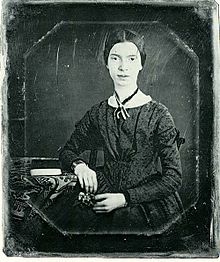Poetry and Books
With a nod to the Pollard Memorial Library blog, here’s a contribution to National Poetry Month that celebrates my favorite pasttime – reading books:
There is no frigate like a book
There is no frigate like a book
To take us lands away
Nor any coursers like a page
Of prancing poetry.
This traverse may the poorest take
Without oppress of toll;
How frugal is the chariot
That bears a human soul!
–Emily Dickinson
Emily Dickinson was born on 10th December, 1830 in the town of Amherst, Massachusetts. Known as “The Belle of Amherst” – Dickinson was regarded as one of America’s greatest poets and is also well known for her unusual life of self imposed social seclusion. Her works include: Because I could not stop for death; I’m nobody! Who are you?; I heard a fly buzz when I died; Sic transit gloria mundi; and I never saw a Moor. Not counting those lost – Emily Dickinson wrote 1,775 poems. She died on December 10, 1830 – her poems were published posthumously.

The local photographer Jim Cryan was once the school photographer for Amherst College. As such he was the curator of what I believe was the glass negative of the photo above of Emily.
Marie: Thanks for this. And Steve, thanks for the factoid about Jim Cryan. Just goes to show how “open” America is. That Jim could find himself in charge of such a rare piece of Americana heritage through work at one of the best colleges in the nation. And that he didn’t have to be the son of a duke or baroness to get the job. I like this story.
I happened to pay a visit to the Emily Dickinson House in Amherst last weekend. The tour included both her childhood home and the family home next door which was built for her brother and remains enitirely as it was when the family lived there….its fascinating…peeling William Morris knock-off wallpaper (they couldn’t afford the real deal) and all. Our guide was wonderful, lots of interesting Dickinson family lore and gossip..for all her fame as a recluse there was lots going on in that household. Another interesting tidbit…despite Amherst College being founded by Emily’s grandfather Samuel Fowler Dickinson, most of Emily’s estate lies with Harvard. I highly recommend a visit.
The glass negative was kept in the climate controlled Library Special Collections, I was trusted with it to make a duplicate 4×5 negative from the original which could then be used to make publication prints.
I’m trying to think of the Special Collections curators last name, his first name was Richard. I remember that he was a great Kerouac fan and had a large collection of original issue Kerouac books.
You know what, Jim? I think those Kerouac books found their way to the UMass Lowell Center for Lowell History special collections library this past year. I can’t recall the name, but the donor was a friend of a librarian who had left the K materials to his friend in his will. The friend contacted UMass Lowell. Talk about closing the loop.
Thinking back 40 years without any research or reflection, especially while on lunch break at the day time job – (they are ALWAYS RIGHT, don’t quit the daytime job) leads to inaccuracies. Further consideration confirms that the original Emily Dickenson Portrait
was probably a Daguerreotype, glass negatives came later. Unresearched memory again but I think 1829 was the invention, (simultaneously in England and France) of photography.
What is so important to this image of Emily is not just that it is the only extant image of the poet, but that it is the only photograph of her ever taken.
I’m guessing again that the friend at Amherst College was named Richard Hughes?